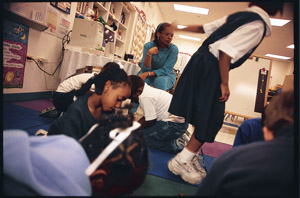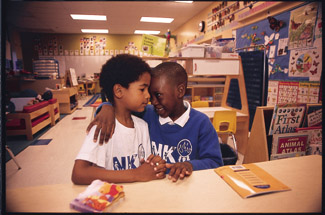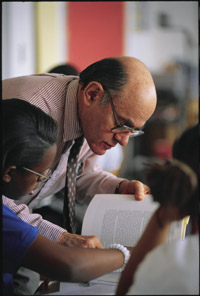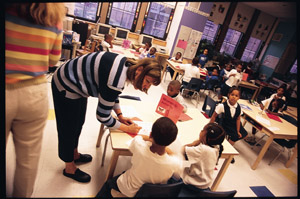Teachable
moments
>> At
North Kenwood/Oakland Charter School-the brainchild of the University's Center
for School Improvement-the aim is to provide quality education for urban families
and professional development for teachers.
The
primary grades' theme for the week at North Kenwood/Oakland Charter School is
"under the sea." Friday is ocean day, and in Debra Fields's kindergarten
room groups of children work on marine-themed projects. At one table a group is
busy teasing small words out of big words. "Stingray: tin, sting, ray, gray,"
reads one girl's paper. She concentrates fiercely, searching for more. A group
at another table writes stories about the ocean. At the room's far end, a boy
sitting at a computer has trouble bringing up an instructional game and signals
the teacher for help.
Fields
comes to his rescue. She seems to be everywhere, encouraging, directing, listening,
correcting. Despite the children's irrepressible energy, they're not unruly. The
room is cheerful with vivid patches of color on the walls, the bookcases, even
the tile floor. On a corkboard hangs the class roster: Shelton, Arthur, Serenity,
Rashawn, Brandon….
 |
Individual
responsibility is a fact of life for everyone - including Debra Field's kindergarten
kids. |
Next
door several parents and grandparents assist Amanda Djikas, the K/1 cluster teacher,
with her spirited charges. Paper cups of Goldfish crackers and Tootie Fruities
sit next to students learning their numbers. Each child bends over a sheet of
paper containing ten rows of ten squares, the rows labeled 0 to 10; by each number
the child must deposit the corresponding number of crackers. One boy, nibbling
on a handful of Goldfish, gets an urge to dart across the room. "Uh-unh,
we are not running," chides Djikas. On a wall hang student essays. One reads:
"My Dad is silly. He dances silly. He writes his ABCs silly. He walks silly.
But he never writes silly at work."
Today
is the last school day before a weeklong break, and the children are looking ahead.
"Miss Mandy" is happy to have parental help. That's something she, like
the school's other teachers, knows she can always count on. "Every time we
need them, they come," she says with a smile.
North
Kenwood/Oakland is a charter school started four years ago by educators at the
University's Center for School Improvement (CSI). NK/O, as it's familiarly known,
is located at 1119 East 46th Street, just north of Hyde Park's 47th Street boundary,
in a neighborhood described not very long ago as having more empty lots than buildings.
The school occupies half of the former Shakespeare School building, shuttered
ten years ago by Chicago Public Schools.
Shakespeare
is NK/O's second home. For the first two years it was housed in an empty church,
Saint James United Methodist at 46th and Ellis, while CSI searched for more ample
quarters. To bring the church up to code, the University invested $475,000, solving
a temporary problem while underwriting a future community asset. (A school for
children with emotional problems now leases the former church.) Four years ago
the neighborhood was not an inviting one; a drug house operated behind the Saint
James building, and a drug-connected murder occurred in front of it.
NK/O
moved into the renovated Shakespeare School in the fall of 2000. It shares the
building with Ariel Community Academy, a "Small School" within the Chicago
Public School system, founded by the Ariel Education Initiative, a program of
Ariel Capital Management Chicago. "Small Schools" are a special category
of public schools that emphasize close student-teacher interaction. Ariel Community
Academy teachers meet regularly with parents and students to discuss student progress,
and they work as a team to build curriculum and share teaching techniques.
The
two schools occupy separate portions of the building, with a few shared facilities:
a multipurpose room, library, cafeteria, and science lab. Unlike Ariel Capital
Academy, North Kenwood/Oakland is not a neighborhood school. Its charter mandates
that it serve students throughout Chicago-though for all practical purposes that
means South Chicago. Nonetheless, about 40 percent of NK/O's 305 students live
in the North Kenwood neighborhood.
 |
Young
scholars Kari Blackburn (left) and Abdouaye Sow wear North Kenwood's no-nonsense
uniforms. |
When
it opened NK/O offered four grades: pre-kindergarten, kindergarten, first, and
fifth. Each year added two more grades (2 and 6, 3 and 7, 4 and 8). This June
NK/O eighth graders participated in the school's first graduation, preceded by
a trip to Detroit and Windsor to visit educational museums, with a stop in Ann
Arbor at the University of Michigan.
Class
sizes range from 18 to 20 at the pre-kindergarten/kindergarten level, 21 to 25
in the primary grades, and 27 in grades 4 through 8. In Chicago Public Schools,
the norms are 28 students in primary grades (K through 3), 34 in intermediate
grades (4 through 6) , and 32 in upper elementary grades (7 and 8), but classes
in the 40 percent of the city's chronically overcrowded elementary schools routinely
exceed those numbers.
Discontent
with the quality of public-school education prompted the emergence of the charter-school
movement in the early 1990s. Thirty-seven states plus the District of Columbia
and Puerto Rico now have laws permitting charter schools-a list that includes
Illinois, whose 1996 legislation allows for 15 schools in Chicago, 15 in the suburbs,
and 15 downstate. Only in Chicago have all 15 charters been allocated.
Charter
schools are public schools with unique missions, including ethnically centered
curricula, emphasis on the performing arts or science, or, in NK/O's case, providing
quality education for urban families and professional development for teachers.
The schools are operated independently by community organizations, universities,
foundations, and teachers. Chicago's charter schools have their own individual
school boards and are open to all students living in the city, tuition-free, with
no academic entrance requirements. Although funded by Chicago Public Schools and
accountable to CPS for student achievement, they control their budgets, school
calendars, hiring and firing, and curricula. For most of the city's charter schools,
this autonomy has produced schools that outdistance their noncharter counterparts
in student attendance, classroom achievement, and parental involvement.
 |
North
Kenwood's director of curriculum Marvin Hoffman teaches an eight-grade social
studies/writing class. |
Marvin
Hoffman is director of curriculum at North Kenwood/Oakland School and the chief
liaison with the University's Center for School Improvement, but he's also NK/O's
founding director. In addition to his administrative duties, he teaches the eighth-grade
social studies/writing class. At 11 o'clock one spring morning, he beams a montage
of disturbing photographs onto a pull-down projection screen in his classroom:
a pack of Nazi storm troopers; men wearing the shabby, mismatched garb of concentration
camp inmates; a six-pointed star, the word Jude in its center.
"Which
of these images suggests power to you?" he asks. Hands shoot up, and the
student selected points to the storm troopers. "Now, do any of these suggest
powerlessness?" More hands: "the concentration camp picture," "the
star." Next he displays an enlarged photo of some anonymous Nazi victims,
one a youngster who is reaching toward the camera, or perhaps toward a woman in
the foreground who might be his mother. "How do you connect this scene with
the scenes we're reading about in Night?" Hoffman asks, then answers
his own question: "Just picture Eleazer in this scene getting herded together
with all the other Jews to be taken off to the camp."
The
eighth graders are reading Elie Wiesel's searing recollections of the Holocaust,
and a few days ago they visited Spertus Museum, whose collection of artifacts
and artwork from Jewish history includes the country's first permanent Holocaust
museum. It is coincidence that Night is also being read across the city
as part of the Chicago Public Library's One Book, One Chicago initiative. Hoffman's
students must keep journals about each reading assignment, but he is unsure whether
all the students exactly grasp what he expects. To give an example, he reads from
his own journal, then asks how the entry differs from a straight report of the
book segment. "You used prior knowledge," a student responds.
"Yes,
I used prior knowledge; I used some of my personal experiences," he agrees.
"But the most important thing is that I really tried to go deep into my own
personal reaction to what I was reading. This reading," he explains, "is
so packed with emotion and so packed with images that are going to stick with
you that you've got to respect them more in the way that you tackle them in your
journal."
A
shift in lunch schedules means that Hoffman's class period is 20 minutes shorter
than usual. He's a little flustered when he realizes he's out of time, and as
the students rise to leave he hurriedly outlines the next assignment. When the
room has emptied, a colleague stops in and asks, "Did you mention that Elie
Wiesel will be giving a lecture shortly at the University?" Hoffman is emphatic:
"I did."
Some
critics of the charter school movement complain of what they see as its elitism.
But charters are not permitted to stack the deck; they can't establish admission
requirements, and if applications exceed the number of places, as they always
do at NK/O, a random lottery is conducted. (For the 2001-2002 school year lottery,
NK/O received 523 applications for 71 slots; for the coming year there were 348
applications for 44 places.) The aim, Hoffman says, is "to prevent charter
schools from creaming top kids. But we have the opposite problem here. Because
we're basically a demonstration school, it's in our interest to maintain a population
that looks as much like the Chicago public schools as possible."
North
Kenwood is undergoing a certain amount of gentrification, and the concern is that
the school's percentage of low-income students is below the average for city schools,
which runs in the 80s and can reach as high as 97 percent. Currently, two out
of three of NK/O's students are on free or reduced lunch, the standard often used
to define poverty level.
Although
the neighborhood upswing began before NK/O's arrival, it's been accelerated by
the school's presence. "That was one of our goals," says Hoffman, "but
it happened much more rapidly than any of us anticipated." Evidence of the
resurgence is not hard to find. The drug house by Saint James has been renovated
into condos, and a handsome town-home development opened last year across the
street from the school. "Every advertisement for the development mentioned
our school, without mentioning that it isn't a neighborhood school," Hoffman
notes. "Sometimes we get angry parents coming over, saying, 'I spent $350,000
to be across the street from this school that I can't send my children to.' "
 |
Eight
grader Kia Smith, part of the first graduating class. |
To
try to keep the low-income component at a reasonable level, administrators regularly
recruit in the neighborhood and its edges, focusing on buildings with high concentrations
of low-income families. They leaflet apartment houses, give presentations in neighborhood
centers, and work through local churches and clubs, stressing their school's educational
results.
Elitism
is only one concern that charter school critics point to. They also fear less
accountability, since charters operate outside the procedures that public schools
must follow. Hoffman rejects that argument. "Part of our accountability and
part of our charter," he says, "is that our kids have to take the same
standardized tests-the Iowa Tests of Basic Skills that the city requires and the
Illinois Standard Achievement Test (ISAT) tests that the state requires. The system
expects us to get where everyone else is getting, but they don't tell us how to
get there."
Most
charters have learned how to get there-but not all. Two were closed for low achievement
scores and poor attendance. Hoffman does not find this discouraging. "One
thing that's appealing about charter schools," he says, "is the accountability
that's built into the renewal process; so the fact that two of the charters went
to schools that have now been closed down is a reflection of the success, not
failure, of the system."
NK/O
students excel in standardized tests, particularly in literacy areas. "Our
writing scores have been consistently above state averages," notes Hoffman.
In fact, ISAT scores in 2001 showed 85 percent of NK/O fifth graders writing at
or above grade standards, compared with 49 percent in the Chicago system and 70
percent statewide. As for reading scores, 54 percent of NK/O fifth graders met
standards for their level, compared with 34 percent in Chicago and 59 percent
statewide. Other reading test data also show an upward trend. For example, only
38.5 percent of the first fifth-grade NK/O class, admitted in 1998, tested at
grade level in a standardized reading test. By the following spring the number
had risen to 64 percent for the same group of children.
Hoffman
concedes that "we're still not there in the math; our kids are doing all
right but not dramatically different from where public school kids are."
NK/O fifth graders were performing at 39 percent of standard in math, below the
statewide 61 percent but above Chicago's 32 percent.
With
the 1996 decision to phase out Chicago's education department, there came a parallel
decision-as Richard Saller (then dean of Social Sciences, now provost) put it-"to
preserve what is most vital in the department." Cited as one of the education's
department's brightest stars was the Center for School Improvement, founded in
1988 to contribute toward better Chicago public schools. To demonstrate the center's
conviction that "ambitious intellectual work for all students can and must
become a reality in Chicago classrooms," CSI has worked with between three
and seven public schools each year in the city's disadvantaged areas. To date,
20 schools have been part of the CSI school network.
NK/O
was created as a demonstration school and a resource for that network. "Our
intent," says CSI director Anthony Bryk, the Marshall Field IV professor
of urban education and sociology, "was to create a place where CSI staff
and school staff can be engaged with one another in co-developing programs and
materials." Although charter schools are able to hire teachers who may not
have all the credentials other public schools require, all of NK/O's subject-area
teachers are credentialed, and 17 of the 21-person teaching staff have master's
degrees.
The
three key administrators also are highly credentialed. Hoffman has a Ph.D. in
clinical psychology from Harvard and has taught from preschool to graduate school.
Kirby Callam, NK/O's director of operations, has a degree from the Yale School
of Management and is the founder and former director of a youth program in Washington
Park, southwest of Kenwood, which offers tutoring, mentoring, and athletic programs
to 100 children aged 3 to 18 and their families. Principal Michael Johnson has
degrees in criminal justice and sociology and formerly directed the Chicagoland
Area High School Leadership Institute for the University of Illinois.
The
triumvirate needs solid management skills to keep up with the school's financial
arrangements. As a public school, most of NK/O's operational monies are public
funds, based on a formula that uses the city's average per-pupil expenditure and
multiplies it by the number of NK/O students. To complicate the financial snapshot,
some program funds pass from the Center for School Improvement to NK/O. Thus,
explains Hoffman, "if we want to pilot a science curriculum that might be
useful in the schools the CSI serves, the Center will pick up some of the development
costs." CSI also funds a portion of some NK/O teachers' salaries in return
for their professional-development services to teachers in its school network.
CSI
director Bryk, whose research explores how the cultural and moral aspects of school
life affect academic performance, compares NK/O to a teaching hospital where the
"interns" are teachers in CSI network schools. Each month these teachers
visit NK/O to study literacy techniques such as guided reading and writers' workshops.
Typically, says Joseph Frattaroli, CSI's deputy director, the network teachers
attend a Friday training session and return the following Monday or Tuesday to
observe NK/O teachers in those areas. The session's last hour is devoted to one-on-one
discussions-a chance, in Fratarolli's words, for the network teachers to "pick
the NK/O teachers' brains."
The
center supplied NK/O's initial leadership and recruited the first teacher cadre.
"Most were recruited from schools in the CSI network," says Bryk. "We
looked for teachers who were excited by the idea of going to a professional-development
school and joining a professional community." Also intriguing was one of
NK/O's distinguishing philosophies, distributive leadership, a term Bryk explains
this way: "Leadership in the school is more than just the principal's job.
It is distributed among the professionals."
As
an adjunct to that philosophy, the salary scale for NK/O teachers is more attractive
than that of their public classroom counterparts-one reason for the high percentage
of credentialed teachers. What teachers earn depends not solely on years of service,
as in city schools, but also on the responsibilities they shoulder. NK/O teachers
begin at parity with public school salaries, where a starting teacher earns about
$34,000 and a teacher with five years of experience and a master's degree earns
in the low $40,000s.
 |
K
/ 1 cluster teacher Amanda Djikas moves from group to group of young scholars. |
"Since
almost all our teachers have come from Chicago public schools," says Hoffman,
"one thing we've had to reassure them about is that there's no loss to them
in moving. We've tried to build a career ladder that allows teachers to advance
both financially and in terms of their role without leaving the classroom."
In addition to regular classroom teachers, there are curriculum coordinators and
lead teachers in each cluster (grades K-1, 2-3, 4-5, and 6-8), who all get add-ons
to their base salaries.
NK/O
also pays into the city pension fund for its teachers, officially considered on
leave from CPS. That means they won't lose seniority if they return to the city
system. But their "leave" extends for only five years, and those who
have been at NK/O from the beginning will decide next year whether to stay or
return to the city schools. Besides losing seniority, staying means losing vestment
in their pre-NK/O bank of sick days; some long-term public school teachers cash
in this bank for more than a year's salary when they retire.
CSI
hopes they'll stay at NK/O. "We will try to keep them with us," says
Bryk, "and we're working on strategies to do that. From the beginning, we
hoped the senior faculty would be permanent, though our long-term vision is to
have some junior positions rotate into the public schools."
When
it comes to student behavior, there is a dramatic difference between NK/O and
many Chicago schools. "We don't have the kinds of problems that other public
schools do," declares Hoffman. "We have behavior problems, but we don't
have violence, we don't have weapons, we don't have drugs, and we don't have gangs,"
all real problems in the upper elementary grades of many public schools. "What
we have are kids who sometimes run in the halls. This is not a matter of selection
of students-because we don't select-but of the school's culture. We don't tolerate
fighting, and kids know what the consequences are."
The
consequences range from stern talks for first offenses to in-house suspension
or full suspension for repeated offenses. Home consequences usually follow, thanks
to what Hoffman calls "our very close relationship with parents. If there
are problems, parents are in on the situation immediately.
"We
don't suspend a lot," he adds, noting that the school's culture encourages
children to meet "the high level of expectation that we have for our students.
You hear this often in schools, but more often than not it's a cliché.
Not here." He credits a mutual "atmosphere of respect" between
students and teachers. "It's kind of shocking to go to some schools-I'm not
saying it's universal-and hear teachers yelling at kids and sort of beating them
down, and there are still some places where there's physical punishment inflicted
on kids."
One
reason teachers say they like NK/O is that they know its cultural norms make yelling
at kids inappropriate. But that's the least of it. "The teachers are here
because they are committed to improving schools, education and individual practice,"
says Stacy Beardsley, an intermediate/upper-level social-studies teacher and NK/O's
technology coordinator. "NK/O is a place where learning about and implementing
the best practices in education is valued and encouraged."
Although
the school is young, few teachers have left. When they do, it's mainly to pursue
opportunities like starting a Ph.D. program or moving into high-school teaching.
"When our teachers complain," says Hoffman, "it's about how demanding
it is to teach here. The investment of time is greater than for teaching in other
schools. But behind the griping there's a recognition that it's really a privilege
to be in a position to shape their teaching lives."
Teaching,
of course, is about shaping other lives too. When Erin Clark entered NK/O in the
fifth grade three years ago, she had reading problems. In two previous schools
she had fallen behind her grade levels, and her mother, Ramona Clark, was worried.
Erin's problem was with reading, not books; she liked it when her mother read
to her.
"I
went to an open house at Kenwood," Clark recalls, "and I was hooked
on the idea that they don't use textbooks; they let children pick the books they
want to read. And they read together in the classroom." For Erin, that made
all the difference. "By sixth grade," her mother says, "she was
reading at grade level." And enjoying it. Now the 12-year-old is an avid
reader, gobbling books even during summer vacations. With one year of elementary
school left for her daughter, Clark worries about the next phase of Erin's education.
"I have to find a good high school for her."
Reading
instruction in the language arts at NK/O focuses on critical thinking rather than
ingesting textbooks. The nontextbook philosophy grows out of a strong literacy
tradition at the CSI and its commitment to project- and inquiry-based learning.
Although language-arts teachers select core books for their classes, students
self-select books for supplemental reading. The science program combines hands-on
experimentation with critical analysis of students' observations. The math program
emphasizes mathematical thinking rather than computation, though that part of
the curriculum is more textbook-oriented than other areas.
Technologically,
NK/O is up to date. Each classroom contains five computers, in addition to the
24 in the school's computer lab. All are connected to the Internet by high-speed
DSL line. Children as early as pre-kindergarten work with Kid Pix, a colorful
computer package with art and photo editing tools. By the seventh grade, students
are using PowerPoint and Excel for class projects; in a unit on Chinese culture,
eighth graders developed their own Web pages. The school's Web site is used increasingly
as a resource for teacher units. Several teachers are creating classroom Web pages,
and a parent page and a homework page are slated for development this summer.
 |
On
hot spring days North Kenwood students have recess in nearby Hyacinth Park, Where
Justin Reeves enjoys a splash in the foutain. |
NK/O's
instructional plan is built around a vigorous assessment program and strategies
to shore up students who are struggling. Nobody is allowed to slip through the
cracks. In a room occupied by the primary literacy coordinator, a giant bulletin
board measuring roughly 10 feet across and four feet tall tracks the reading progress
of all NK/O children. Each child in the primary grades has a Post-It note showing
his or her reading progress on a 12-step assessment scale. Teachers keep the Post-Its
up to date and can see at a glance how their students are performing, if they're
progressing, what special services they're receiving, and whether they need more
challenging assignments.
It's
not only middle-class parents like Ramona Clark who appreciate NK/O. The appreciation
level tends to run even higher in low-income families, says Hoffman. All parents
volunteer for classroom duty when they can, and they are faithful in attending
school events. "We conduct parent surveys annually, and the satisfaction
level is always very high," says Hoffman. "Putting the 'satisfied' and
'very satisfied' categories together, we always exceed 90 percent." When
students withdraw from NK/O-roughly a dozen so far-it may be because the school
has recommended therapy for the child or because students want special seventh-grade
programs available elsewhere that prepare them for particular high schools.
Shh,
shh, shh," admonishes librarian Elizabeth Bischoff as she leads a straggly
line of 20 kindergartners into her book-lined domain. It's near the school day's
end, and some of the children's pent-up energy is in serious danger of spilling
over. Four youngsters dash to squeeze onto a couch built for three, and some shoving
and hurt looks follow. The librarian plucks one of the kids from the mix, and
things settle down on the couch.
"Does
anyone remember what we do when we find a book we want to check out?" Bischoff
asks, pausing to threaten one little boy with a timeout. The children remember,
and they scatter on cue to pick out the books they'll take home. Several choose
books about fish-sharks, dolphins, and whales are favorites-reflecting the week's
under-the-sea theme. While others continue to make their choices, the librarian
shepherds the quick pickers back to a set of beanbag chairs. "Now it is quiet
time where you're sitting," she announces. "It's reading time."
The children are mostly interested in the books' pictures, but a few pick out
familiar words.
Gradually
the activity level subsides. When the librarian counts heads, she finds one boy
is missing and tracks him down among the stacks, still hunting. He explains, "I
need a short book 'cause I got to go to bed real early."
At
the checkout counter the children present their books for scanning, one at a time.
When they're finished they go to a table and read their selections while their
classmates continue checking out. Twenty minutes later it's time to line the children
up again and march them back to the corridor where their homeroom teacher will
meet them. After the handover Elizabeth Bischoff steps back and gazes at the departing
kids, each with two books clutched in their hands or under their arms. She reassures
a visitor who wonders how many of the books will come back. "I get almost
100 percent returns," she says with satisfaction.


![]()





